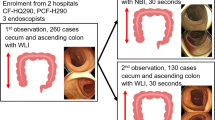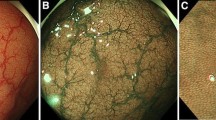Abstract
Purpose
Previous studies have yielded conflicting results on the colonic polyp detection rate with narrow-band imaging (NBI) compared with white-light imaging (WLI). We compared the mean number of colonic polyps detected per patient for NBI versus WLI using a next-generation NBI system (EVIS LUCERA ELITE; Olympus Medical Systems) used with standard-definition (SD) colonoscopy and wide-angle (WA) colonoscopy.
Methods
Design: this study is a 2 × 2 factorial, prospective, multicenter randomized controlled trial. Setting: this study was conducted at five academic centers in Japan. Interventions: patients were allocated to one of four groups: (1) WLI with SD colonoscopy (H260AZI), (2) NBI with SD colonoscopy (H260AZI), (3) WLI with WA colonoscopy (CF-HQ290), and (4) NBI with WA colonoscopy (CF-HQ290). Main outcome: the mean numbers of polyps detected per patient were compared between the four groups: WLI with/without WA colonoscopy and NBI with/without WA colonoscopy.
Results
Of the 454 patients recruited, 431 patients were enrolled. The total numbers of polyps detected by WLI with SD, NBI with SD, WLI with WA, and NBI with WA were 164, 176, 188, and 241, respectively. The mean number of polyps detected per patient was significantly higher in the NBI group than in the WLI group (2.01 vs 1.56; P = 0.032). The rate was not higher in the WA group than in the SD group (1.97 vs 1.61; P = 0.089).
Conclusions
Although WA colonoscopy did not improve the polyp detection, next-generation NBI colonoscopy represents a significant improvement in the detection of colonic polyps.



Similar content being viewed by others
References
Walsh JM, Terdiman JP (2003) Colorectal cancer screening: scientific review. JAMA 289:1288–296
Winawer SJ, Zauber AG, Ho MN et al (1993) The national polyp study workgroup. Prevention of colorectal cancer by colonoscopic polypectomy. N Engl J Med 29:1977–1981
Zauber AG, Winawer SJ, O’Brien MJ et al (2012) Colonoscopic polypectomy and long-term prevention of colorectal-cancer deaths. N Engl J Med 366:687–696
van Rijn JC, Reitsma JB, Stoker J et al (2006) Polyp miss rate determined by tandem colonoscopy: a systematic review. Am J Gastroenterol 101:343–350, Review
Gono K, Obi T, Yamaguchi M et al (2004) Appearance of enhanced tissue feature in narrow-band endoscopic imaging. J Biomed Opt 9:568–577
Muto M, Minashi K, Yano T et al (2010) Early detection of superficial squamous cell carcinoma in the head and neck region and esophagus by narrow band imaging: a multicenter randomized controlled trial. J Clin Oncol 28:1566–1572
East JE, Suzuki N, Stavrinidis M et al (2008) Narrow band imaging for colonoscopic surveillance in hereditary non-polyposis colorectal cancer. Gut 57:65–70
Inoue T, Murano M, Murano N et al (2008) Comparative study of conventional colonoscopy and pan-colonic narrow-band imaging system in the detection of neoplastic colonic polyps: a randomized, controlled trial. J Gastroenterol 43:45–50
Rex DK, Helbig CC (2007) High yields of small and flat adenomas with high-definition colonoscopes using either white light or narrow band imaging. Gastroenterology 133:42–47
Adler A, Ashenbeck J, Yenerim T et al (2009) Narrow-band versus white-light high definition television endoscopic imaging for screening colonoscopy: a prospective randomized trial. Gastroenterology 136:410–416
Rastogi A, Early DS, Gupta N et al (2011) Randomized, controlled trial of standard-definition white-light, high-definition white-light, and narrow-band imaging colonoscopy for the detection of colon polyps and prediction of polyp histology. Gastrointest Endosc 74:593–602
Sabbagh LC, Reveiz L, Aponte D, et al. Narrow-band imaging does not improve detection of colorectal polyps when compared to conventional colonoscopy: a randomized controlled trial and meta-analysis of published studies. BMC Gastroenterol. 2011;23;11:100.
Ikematsu H, Saito Y, Tanaka S et al (2012) The impact of narrow band imaging for colon polyp detection: a multicenter randomized controlled trial by tandem colonoscopy. J Gastroenterol 47:1099–1107
East JE, Ignjatovic A, Suzuki N et al (2012) A randomized, controlled trial of narrow-band imaging vs high-definition white light for adenoma detection in patients at high risk of adenomas. Colorectal Dis 14:e771–e778
Nagorni A, Bjelakovic G, Petrovic B (2012) Narrow band imaging versus conventional white light colonoscopy for the detection of colorectal polyps. Cochrane Database Syst Rev 1:CD008361
Dinesen L, Chua TJ, Kaffes AJ (2012) Meta-analysis of narrow-band imaging versus conventional colonoscopy for adenoma detection. Gastrointest Endosc 75:604–611
Pasha SF, Leighton JA, Das A et al (2012) Comparison of the yield and miss rate of narrow band imaging and white light endoscopy in patients undergoing screening or surveillance colonoscopy: a meta-analysis. Am J Gastroenterol 107:363–370
Jin XF, Chai TH, Shi JW et al (2012) Meta-analysis for evaluating the accuracy of endoscopy with narrow band imaging in detecting colorectal adenomas. J Gastroenterol Hepatol 27:882–887
Guidelines for colonoscopy surveillance after polypectomy: a consensus update by the US Multi-Society Task Force on Colorectal Cancer and the American Cancer Society. Gastroenterology. 2006;130:1872–1885.
Heresbach D, Barrioz T, Lapalus MG et al (2008) Miss rate for colorectal neoplastic polyps: a prospective multicenter study of back-to-back video colonoscopies. Endoscopy 40:284–290
Morini S, Hassan C, Zullo A et al (2009) Detection of colonic polyps according to insertion/withdrawal phases of colonoscopy. Int J Colorectal Dis 24:527–530
Tsuda S, Veress B, Toth E et al (2002) Flat and depressed colorectal tumours in a southern Swedish population: a prospective chromoendoscopic and histopathological study. Gut 51:550–555
Soetikno R, Friedland S, Kaltenbach T et al (2006) Nonpolypoid (flat and depressed) colorectal neoplasms. Gastroenterology 130:566–576
Sugai T, Habano W, Jiao YF et al (2006) Analysis of molecular alterations in left- and right-sided colorectal carcinomas reveals distinct pathways of carcinogenesis: proposal for new molecular profile of colorectal carcinomas. J Mol Diagn 8:193–201
Snover DC (2011) Update on the serrated pathway to colorectal carcinoma. Hum Pathol 42:1–10
Sano Y, Horimatsu T, Fu KI et al (2006) Magnifying observation of microvascular architecture of colorectal lesions using a narrow-band imaging system. Dig Endosc 18:S44–S51
Barclay RL, Vicari JJ, Doughty AS et al (2006) Colonoscopic withdrawal times and adenoma detection during screening colonoscopy. N Engl J Med 355:2533–2541
Rex DK (2006) Maximizing detection of adenomas and cancers during colonoscopy. Am J Gastroenterol 101:2866–2877
Winawer SJ, Zauber AG, Fletcher RH et al (2006) Guidelines for colonoscopy surveillance after polypectomy: a consensus update by the US Multi-Society Task Force on Colorectal Cancer and the American Cancer Society. Gastroenterology 130:1872–1885
Hassan C, Quintero E, Dumonceau JM et al (2013) Post-polypectomy colonoscopy surveillance: European Society of Gastrointestinal Endoscopy (ESGE) Guideline. Endoscopy 45:842–851
Acknowledgments
We thank all investigators who cooperated in recruiting patients at the five participating centers.
Author contributions
Study concept and design: Takahiro Horimatsu, Yasushi Sano, Manabu Muto, and Hisao Tajiri; acquisition of data: Shiro Oka, Takuji Kawamura, Shoichi Saito, Mineo Iwatate, Koji Uno, Naoto Tamai, and Shinji Tanaka; analysis and interpretation of data: Hideki Ishikawa; and statistical analysis: Kenichi Yoshimura.
Author information
Authors and Affiliations
Corresponding author
Rights and permissions
About this article
Cite this article
Horimatsu, T., Sano, Y., Tanaka, S. et al. Next-generation narrow band imaging system for colonic polyp detection: a prospective multicenter randomized trial. Int J Colorectal Dis 30, 947–954 (2015). https://doi.org/10.1007/s00384-015-2230-x
Accepted:
Published:
Issue Date:
DOI: https://doi.org/10.1007/s00384-015-2230-x




